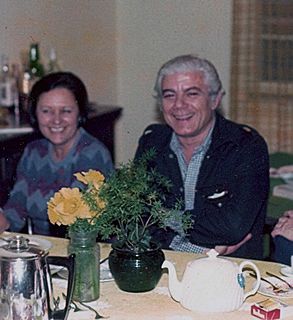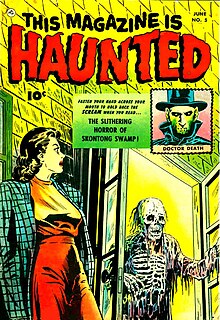Charlton Comics was an American comic book publishing company that existed from 1945 to 1986, having begun under a different name in 1940. It was based in Derby, Connecticut. The comic-book line was a division of Charlton Publications, which published magazines, puzzle books and, briefly, books. It had its own distribution company.

An American comic book is a thin periodical originating in the United States, on average 32 pages, containing comics. While the form originated in 1933, American comic books first gained popularity after the 1938 publication of Action Comics, which included the debut of the superhero Superman. This was followed by a superhero boom that lasted until the end of World War II. After the war, while superheroes were marginalized, the comic book industry rapidly expanded and genres such as horror, crime, science fiction and romance became popular. The 1950s saw a gradual decline, due to a shift away from print media in the wake of television and the impact of the Comics Code Authority. The late 1950s and the 1960s saw a superhero revival and superheroes remained the dominant character archetype throughout the late 20th century into the 21st century.

John V. Romita is an American comic book artist best known for his work on Marvel Comics' The Amazing Spider-Man and for co-creating characters including the Punisher and Wolverine. He was inducted into the Will Eisner Comic Book Hall of Fame in 2002.

Fawcett Comics, a division of Fawcett Publications, was one of several successful comic book publishers during the Golden Age of Comic Books in the 1940s. Its most popular character was Captain Marvel, the alter ego of radio reporter Billy Batson, who transformed into the hero whenever he said the magic word "Shazam!".

Whiz Comics was a monthly ongoing comic book anthology series, published by Fawcett Comics from 1940–1953, best known for introducing Captain Marvel.

Hoppy the Marvel Bunny is a fictional comic book superhero and funny animal originally published by Fawcett Comics as a spin-off of Captain Marvel. He was created by Chad Grothkopf (1914–2005), and debuted in Fawcett's Funny Animals #1. Hoppy later became a property of DC Comics, and has made periodic appearances in stories related to Captain Marvel, today also known as Shazam.
Marcus Desha Swayze, known as Marc Swayze, was an American comic book artist from 1941 to 1953 for Fawcett Comics of New York City.

Vincenzo Colletta was an American comic book artist and art director best known as one of Jack Kirby's frequent inkers during the 1950s-1960s period called the Silver Age of comic books. This included some significant early issues of Marvel Comics' Fantastic Four, and a long, celebrated run on the character Thor in Journey into Mystery and The Mighty Thor.

Atlas Comics is the 1950s comic-book publishing label that evolved into Marvel Comics. Magazine and paperback novel publisher Martin Goodman, whose business strategy involved having a multitude of corporate entities, used Atlas as the umbrella name for his comic-book division during this time. Atlas evolved out of Goodman's 1940s comic-book division, Timely Comics, and was located on the 14th floor of the Empire State Building.

L. Miller & Son, Ltd. was a British publisher of magazines, comic books, and pulp fiction intended primarily to take advantage of the British ban on importing printed matter. Between 1943 and 1966, the firm published British editions of many American comic books, primarily those of Fawcett Comics. They are best known for the 1954 creation of Marvelman – a blatant imitation of the Golden Age Captain Marvel – after America's Fawcett Publications capitulated to National Periodicals. L. Miller & Son also published a large line of Western comics, many reprints but also some original titles.

Romance comics is a comics genre depicting strong and close romantic love and its attendant complications such as jealousy, marriage, divorce, betrayal, and heartache. The term is generally associated with an American comic books genre published through the first three decades of the Cold War (1947–1977). Romance comics of the period typically featured dramatic scripts about the love lives of older high school teens and young adults, with accompanying artwork depicting an urban or rural America contemporaneous with publication.

This Magazine is Haunted was a horror comic originally published by Fawcett between 1951 and 1953. Running 14 issues, it was the first of Fawcett's supernatural line; a string of titles which included Beware! Terror Tales, Worlds of Fear, Strange Suspense Stories, and Unknown Worlds.

Young Romance is a romantic comic book series created by Joe Simon and Jack Kirby for the Crestwood Publications imprint Prize Comics in 1947. Generally considered the first romance comic, the series ran for 124 consecutive issues under Prize imprint, and a further 84 published by DC Comics after Crestwood stopped producing comics.
Alan Class Comics was a British comics publishing company between 1959 and 1989, owned by Alan Class. The company produced anthology titles, reprinting comics stories from many U.S. publishers of the 1940s to 1960s in a black and white digest size format for a UK audience.

Space Adventures was an American science-fiction anthology comic book series published sporadically by Charlton Comics from 1952 to 1979. Its initial iteration included some of the earliest work of industry notables Steve Ditko, Dick Giordano, and Tony Tallarico, and at least one story by EC Comics mainstay Bernard Krigstein.

Girl Comics is the name of two comic-book series published by Marvel Comics and its forerunners, Timely Comics and Atlas Comics. The first, debuting in 1949, ran 35 issues, changing its title to Girl Confessions with issue #13. The second was a three-issue limited series published in 2010.

"There's No Love in Rock and Roll" is a 6-page comic book story from True Life Romance, No. 3 published by Ajax in August 1956. The plot concerns defiant teenager Shirley and the irritation she causes her parents by dating a boy who loves rock and roll. Shirley tells the reader on the first page: "No one understands the teenagers? That's because they don't want to be understood! It points out our flaws! Our pretense that were so important, that we have to have a world of our own!" She ultimately renounces the boy and meets a square-shooter who likes traditional adult music. Her parents are thrilled. Shirley states in the last panel, "Gee! I can't believe that I ever enjoyed that horrible rock and roll stuff—it's just plain noise!" The story was published in the infancy of rock and roll and was reprinted by indie publisher New England Comics in "My Terrible Romance" in 1994.

Western comics is a comics genre usually depicting the American Old West frontier and typically set during the late nineteenth century. The term is generally associated with an American comic books genre published from the late 1940s through the 1950s. Western comics of the period typically featured dramatic scripts about cowboys, gunfighters, lawmen, bounty hunters, outlaws, and Native Americans. Accompanying artwork depicted a rural America populated with such iconic images as guns, cowboy hats, vests, horses, saloons, ranches, and deserts, contemporaneous with the setting.
Zena Brody worked for DC Comics as an editor for the romance comics line during the golden age of comics. On her appointment in 1949, Brody was the first ever woman comics editor.













